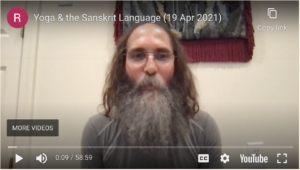Sanskrit Challenge: May ’21
Sanskrit Challenge: May ’21
Let’s explore this ancient yet living language, and expand our knowledge of Sanskrit!!
Overview
The Sanskrit Challenge shall proceed on multiple levels and will allow you to interact with it via various media. This page will grow and develop over the course of the month so check back and see what’s new.
Outline of this blog post:
(I) Link to listen to last month’s talk on Sanskrit
(II) Listing of Sanskrit “Word of the Day”
(III) Pose Your Query: Zoom Talks
(I) Talk on Sanskrit – April 2021
(II) Sanskrit Words of the Day
Here is our listing to date….
The Namaste Dogma & Bowing: This is basically required reading. Kudos to Sharon (see comments section of the above Sanskrit Talk blog post) for providing the initiative to bring this to fruition.
—-
Satya
The meaning is benevolent truthfulness. To speak for the welfare of others. Factual truth in Sanskrit is known as rta (pronounced rita), and most of the time satya and rta are perfectly coordinated. But there are occasions where they differ.
Suppose it is wartime and you are hiding 6 children in your basement and the malevolent invading soldiers come to your house in search of the children in order to kill them. Then if they ask you if the children are in your house are you going to say yes?
Of course not. You are going to speak for the welfare of those innocent children. You will say they are not here or they are across town etc. That response is satya and perfectly aligned with dharma. To give the literally, factual response (rta) wherein the children are executed is a total injustice.
Again most of the time satya and rta are the same, but we should always remember that ours is the path of satya. Therein lies our true dharma.
—-
Moha (the last letter “a” is silent)
Moha means blind attachment, i.e. when we do things or espouse ideas that are illogical, irrational, and harmful, but we do them anyway because we cannot break away from our old bad habits or myopic viewpoints adopted due to indoctrination / social samskara. The yogis say that moha is the most detrimental characteristic in human life.
Some common examples of moha are:
– cigarette smoking
– racism
– eating unhealthy foods
In contrast, the yogis say the greatest human quality is a sense of duty based on dharma and service to others.
—–
Dharma
Dharma has a few meanings. First it means the inherent characteristic or nature of something. For instance, the dharma of a bird is to fly, and the dharma of fire is to burn. And the dharma of human beings is psycho-spiritual expansion and to realize their true self.
Next dharma also refers to righteousness or morality. An action is said to be dharmic to the degree it is aligned with the yoga code of moral conduct, i.e. for the betterment of universal humanity.
(III) Pose Your Query: Zoom Talks
After you have watched the talk in section 1, if you have any further queries, contact us to schedule a time to pose your query via Zoom wherein we will record your query and the response and post it here.

